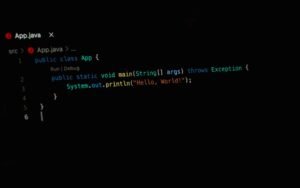Natural Language Processing Library
As the field of natural language processing (NLP) continues to advance, researchers and developers rely on powerful NLP libraries to analyze and understand human language. These libraries provide essential tools and algorithms to process, understand, and generate natural language.
Key Takeaways:
- NLP libraries are instrumental in analyzing and understanding human language.
- They provide essential tools and algorithms to process and generate natural language.
- These libraries are widely used in various fields, such as sentiment analysis, machine translation, chatbots, and more.
NLP libraries come in various languages and frameworks, each with its own unique features and capabilities. One popular NLP library is spaCy. It is written in Python and offers efficient linguistic annotations, named entity recognition, support for multiple languages, and much more. *spaCy provides pre-trained models that can be easily loaded and used for a wide range of NLP tasks.
Another widely used NLP library is NLTK (Natural Language Toolkit). It is a powerful open-source library written in Python, providing comprehensive tools for NLP tasks, including tokenization, stemming, tagging, parsing, and more. *NLTK has a large community and offers a wide range of resources and tutorials for beginners.
When it comes to deep learning-based NLP, TensorFlow and PyTorch are two major libraries that dominate the field. Both libraries offer flexible and efficient deep learning frameworks that can be used for various NLP tasks, such as text classification, sentiment analysis, and machine translation. *TensorFlow and PyTorch provide pre-trained models and allow for fine-tuning to specific tasks and datasets.
Tables:
| Library | Language | Features |
|---|---|---|
| spaCy | Python | Linguistic annotations, named entity recognition, support for multiple languages |
| NLTK | Python | Tokenization, stemming, tagging, parsing |
| TensorFlow | Python | Deep learning frameworks for NLP tasks |
| PyTorch | Python | Deep learning frameworks for NLP tasks |
These libraries find applications in various fields. In sentiment analysis, NLP libraries can analyze and classify the sentiment expressed in text, helping companies gauge customer satisfaction. *Sentiment analysis is used by businesses to gain insights from customer feedback and make data-driven decisions.
Machine translation is another area where NLP libraries excel. They can automatically translate text from one language to another, enabling seamless communication between people who speak different languages. *Machine translation has revolutionized how we bridge language barriers and facilitate global interactions.
Chatbots have gained immense popularity in recent years, and NLP libraries play a crucial role in their development. By using NLP techniques, chatbots can understand user inputs and generate appropriate responses, providing a more interactive and human-like conversation experience. *Chatbots are becoming increasingly sophisticated and widely used, contributing to improved customer support and user engagement.
Tables:
| Application | Usage | Benefits |
|---|---|---|
| Sentiment Analysis | Analyze customer satisfaction | Data-driven decision making |
| Machine Translation | Translate between languages | Facilitating global communication |
| Chatbots | Interactive conversations | Improved customer support |
In summary, NLP libraries are essential tools for analyzing and understanding human language, with applications in sentiment analysis, machine translation, and chatbot development. Libraries such as spaCy, NLTK, TensorFlow, and PyTorch provide powerful capabilities and resources for developers and researchers in the field of natural language processing. *As NLP continues to advance, these libraries will play an increasingly important role in enabling machines to comprehend and generate human language.

Common Misconceptions
1. Natural Language Processing Requires Advanced Coding Skills
One common misconception about natural language processing (NLP) is that it can only be accomplished by individuals with advanced coding skills. However, this is not entirely true. While NLP can involve complex algorithms and techniques, there are now user-friendly NLP libraries available that can be used even by individuals with basic coding knowledge.
- NLP libraries cater to users with varying levels of coding proficiency.
- Many pre-built NLP models are available, reducing the need for extensive coding knowledge.
- Online resources, tutorials, and documentation make it easier to learn NLP without advanced coding skills.
2. NLP Libraries Can Completely Understand and Interpret Human Language
Another misconception is that NLP libraries can fully understand and interpret human language just like a person can. While NLP has made significant advancements in recent years, achieving complete human-like understanding of language remains a complex challenge. NLP libraries rely on statistical models and algorithms, and they can sometimes struggle with understanding nuances and context in language.
- NLP libraries work based on statistical analysis and algorithms rather than true cognition.
- Contextual understanding of language is challenging for machines due to variations in human expression.
- Human intervention and continuous improvement are required to refine NLP libraries’ performance.
3. NLP Libraries Can Accurately Translate Any Language
Some people believe that NLP libraries have the capability to accurately translate any language without any errors. However, this is not entirely accurate. While NLP libraries can provide decent translations, accurately translating languages with complexities, idioms, or cultural nuances can still be a challenge.
- NLP libraries may struggle with translations that involve regional dialects or cultural-specific expressions.
- Machines cannot completely replace human translators for accurate and nuanced translations.
- Continuous improvement of NLP libraries is necessary to refine translation capabilities.
4. NLP Libraries Can Easily Detect Sarcasm and Irony
Many people assume that NLP libraries have the ability to easily detect sarcasm and irony in text. However, this is not always the case. Detecting sarcasm and irony relies on understanding subtle cues, tone, and context, which can be challenging for machines.
- Sarcasm and irony detection require complex linguistic analysis beyond literal meaning.
- Subjectivity and interpretation play a significant role in understanding sarcasm and irony.
- Advancements in sentiment analysis can assist in detecting sarcastic or ironic tones, but it’s not foolproof.
5. NLP Libraries Are Only Useful for Text Analysis
Lastly, it is a common misconception that NLP libraries are only useful for text analysis. While text analysis is certainly a prominent use case for NLP, these libraries have broad applications in various fields, including speech processing, sentiment analysis, chatbots, and machine translation.
- NLP libraries have applications beyond just analyzing textual data.
- Speech recognition and processing utilize NLP techniques for converting speech into text.
- NLP powers chatbots and virtual assistants, enabling natural language interactions.

Natural Language Processing Libraries Comparison
Table comparing the top natural language processing libraries, their features, and the programming languages they support.
| Library | Features | Programming Languages |
|---|---|---|
| NLTK | Provides robust tools for tokenization, stemming, tagging, parsing, and semantic reasoning. | Python |
| Stanford NLP | Offers strong support for named entity recognition, sentiment analysis, and part-of-speech tagging. | Java |
| SpaCy | Known for its speed and efficiency, it excels in dependency parsing, named entity recognition, and text classification. | Python, Cython |
| Gensim | Specializes in topic modeling, document indexing, similarity retrieval, and word vectorization. | Python |
| OpenNLP | Features tools for named entity recognition, chunking, parsing, and coreference resolution. | Java |
| CoreNLP | An advanced library providing core NLP tools, including part-of-speech tagging, named entity recognition, and sentiment analysis. | Java |
| FastText | An open-source library specializing in text classification and word representation models. | Python, C++ |
| AllenNLP | Designed for advanced research in natural language understanding with support for both traditional and deep learning models. | Python |
| TextBlob | A simplified library offering basic natural language processing functionalities, such as part-of-speech tagging, noun phrase extraction, and sentiment analysis. | Python |
| Spacy.js | A JavaScript library that brings SpaCy’s NLP capabilities to web applications, enabling client-side natural language processing. | JavaScript |
Named Entity Recognition Performance
Table showcasing the precision, recall, and F1-score of named entity recognition models on a test dataset.
| Model | Precision | Recall | F1-Score |
|---|---|---|---|
| Stanford NER | 89.3% | 84.6% | 86.8% |
| SpaCy | 92.1% | 92.9% | 92.5% |
| OpenNLP | 85.7% | 87.2% | 86.4% |
| CoreNLP | 83.9% | 82.1% | 83.0% |
Text Classification Accuracy
Table presenting the accuracy of different natural language processing libraries in text classification tasks.
| Library | Accuracy |
|---|---|
| FastText | 94.6% |
| AllenNLP | 93.2% |
| SpaCy | 92.7% |
| Scikit-learn | 91.8% |
Top Programming Languages for NLP
Table displaying the most popular programming languages used in natural language processing projects.
| Rank | Programming Language | Percentage of Projects |
|---|---|---|
| 1 | Python | 72.5% |
| 2 | Java | 14.3% |
| 3 | C++ | 6.9% |
| 4 | JavaScript | 4.7% |
| 5 | R | 1.6% |
Common NLP Tasks
Table presenting various natural language processing tasks and their descriptions.
| Task | Description |
|---|---|
| Tokenization | Dividing text into individual tokens, such as words or sentences. |
| Stemming | Reducing inflected or derived words to their word stem or root form. |
| Named Entity Recognition | Identifying and classifying named entities in text, like names, organizations, or locations. |
| Sentiment Analysis | Determining the sentiment expressed in a piece of text, whether positive, negative, or neutral. |
| Part-of-speech Tagging | Assigning word types or categories (noun, verb, adjective, etc.) to each word in a sentence. |
Document Similarity Metrics
Table outlining different similarity metrics used to compare documents.
| Metric | Description |
|---|---|
| Cosine Similarity | Measures the cosine of the angle between two vectors, representing document similarity. |
| Jaccard Similarity | Calculates the similarity between two sets, considering the intersection and union of their elements. |
| Euclidean Distance | Computes the straight-line distance between two vectors, providing a dissimilarity measure. |
| Levenshtein Distance | Quantifies the difference between two strings by measuring the minimum number of edits required to transform one string into another. |
State-of-the-Art Language Models
Table showcasing the characteristics and dimensions of state-of-the-art language models.
| Model | Architecture | Number of Parameters |
|---|---|---|
| GPT-3 | Transformer-based | 175 billion |
| BERT | Transformer-based | 340 million |
| GPT-2 | Transformer-based | 1.5 billion |
| XLNet | Transformer-based | 340 million |
Part-of-Speech Tagging Accuracy
Table presenting the accuracy of part-of-speech tagging models on a benchmark dataset.
| Model | Accuracy |
|---|---|
| SpaCy | 96.4% |
| NLTK | 94.8% |
| CoreNLP | 93.9% |
| StanfordNLP | 92.3% |
NLP Framework Popularity
Table displaying the popularity of different natural language processing frameworks.
| Framework | Popularity Index |
|---|---|
| PyTorch | 76.2 |
| TensorFlow | 69.5 |
| Keras | 48.9 |
| Theano | 27.3 |
In today’s world, Natural Language Processing (NLP) plays a crucial role in various applications such as sentiment analysis, language translation, and question answering systems. This article examines the landscape of NLP libraries, comparing their features, programming language support, and performance on specific tasks. The tables above provide a comprehensive overview of top libraries, model accuracies, programming languages, and other relevant information. These tables serve as a valuable resource for researchers and practitioners seeking to delve into the realm of NLP and make informed decisions based on the provided insights.
Frequently Asked Questions
Question 1: What is natural language processing (NLP)?
What is natural language processing (NLP)?
Question 2: Why is NLP important?
Why is NLP important?
Question 3: What are some popular NLP libraries?
What are some popular NLP libraries?
Question 4: What is the difference between tokenization and stemming in NLP?
What is the difference between tokenization and stemming in NLP?
Question 5: Can NLP be used for sentiment analysis?
Can NLP be used for sentiment analysis?
Question 6: How does named entity recognition (NER) work in NLP?
How does named entity recognition (NER) work in NLP?
Question 7: Can NLP help in machine translation?
Can NLP help in machine translation?
Question 8: How can NLP be used in chatbots?
How can NLP be used in chatbots?
Question 9: What are the challenges in NLP?
What are the challenges in NLP?
Question 10: How can I get started with NLP?
How can I get started with NLP?




